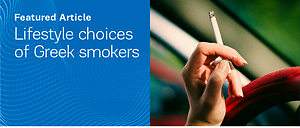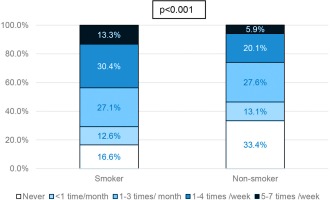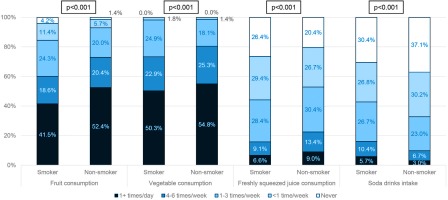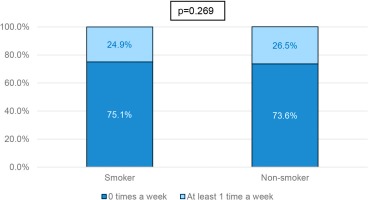INTRODUCTION
Tobacco use is a documented health risk factor responsible for 8 million deaths worldwide every year1. While smoking prevalence has been showing a declining trend worldwide2 and in Greece3, there is still a large population of current tobacco users, estimated to be 1.3 billion globally1. Smoking cessation is a demanding and challenging task, often unsuccessful; as per the World Health Organization’s 2018 data in the USA, from 21.5 million smokers who attempted to quit, only 2.9 million (7.5%) were successful4, indicating that there is room to improve cessation programs through a more inclusive yet individualized approach.
The use of tobacco products has been associated with lifestyle choices such as unhealthy dietary habits5,6 and lack of exercise7,8, while smoking cessation has been associated with healthier lifestyle choices5. A study by LaCroix et al.9 in the early 1990s showed that maintaining a healthy lifestyle can improve life expectancy and reduce the risk of mobility loss later in life. A more recent study by Alkerwi et al.10 highlighted the association between the intensity of tobacco use and unhealthy nutrition. Similar findings were observed in the study by Lohse et al.11 in which they observed that heavy smoking was associated with a general unhealthy lifestyle in Switzerland. Furthermore, studies have shown that physical exercise can assist smoking cessation attempts12,13.
The majority of studies looking into lifestyle choices of smokers have been conducted in the early 1990s9,14,15, while most recent studies have focused on the combination of tobacco use, nutrition and/or exercise in the context of a specific health condition or disease such as asthma16 or cancer17 and in many cases in a specific subgroup of the population, for example in students18. A few existing recent studies that have focused on smokers’ lifestyle choices have been conducted in the USA6, Luxembourg10 and Switzerland11. In Greece, in the Attica study conducted between 2001–2002, researchers found a synergistic effect of smoking and coffee consumption in increased homocysteine levels, with it being more intense when higher amounts of cigarettes and coffee were consumed19. Furthermore, in a study by Anyfanti et al.20 researchers observed that smoking prior to exercise increased myocardial stress and dysregulated baroreceptor sensitivity, while more recent studies have mainly focused on the estimation of smoking prevalence3,21-24 as well as smoking cessation25,26 at a national or local level.
To the authors knowledge, there is a lack of studies looking into the lifestyle choices of the tobacco user in Greece. Therefore, the aim of the current study was to firstly identify lifestyle choices that are more often presented by smokers, by examining healthy diet, excessive alcohol intake, physical exercise and health monitoring by physicians; and secondly, to describe the tobacco user’s profile in modern Greece.
METHODS
Dataset
Data were obtained by the most recent Health Survey conducted by the Hellenic Statistical Authority (ELSTAT) in 2019. ELSTAT conducts a health survey every five years, in which detailed information is gathered regarding health issues, risk factors, use of health services and social support and assistance. The 2019 Health Survey consisted of 8125 participants aged ≥15 years. The dataset comes with a weighting factor, produced by ELSTAT, to become representative of the Greek population.
Statistical analysis
Analysis was performed for survey data, using the weights as the frequency variable. Analysis was focused on differences between smokers and non-smokers regarding a number of lifestyle choices, including healthy diet (consumption of fruit, vegetable, freshly squeezed juice, soda drinks and alcohol), exercise and health monitoring by a health professional (measurements of blood pressure, cholesterol and glucose levels by a health professional, and appointments with physicians). Variables regarding lifestyle choices were measured on a weekly/monthly basis, exercise was measured on a weekly basis whereas variables regarding health monitoring were measured on a yearly basis. Chi-squared tests were used to assess differences between smokers and non-smokers.
Ordered logistic regression models were performed for each lifestyle choice, to evaluate whether they were associated with smoking after adjusting for other risk factors (sex, age, area of residence, educational level and working status). Statistical significance of each risk factor with the dependent variable of every model was tested with chi-squared tests prior to the inclusion in the models. Furthermore, the interaction of smoking with age and sex was tested for inclusion in all models. Backward elimination procedure was used to conclude to the final models. The variables showing consumption of fruit, vegetable and freshly squeezed juice were merged into one which was used as the dependent variable in one of the models. The newly created variable took values from 1 to 5, with 1 indicating 1+ times/day (if they consume at least one of these products at least once a day), 2 indicating 4–6 times/week (if the maximum consumption of one or more of these products is 4–6 times/week), 3 indicating 1–3 times/week, 4 indicating <1 time/week and 5 indicating never (if they never consume any of these products). Similarly, the variables showing health monitoring, i.e. blood pressure, cholesterol and blood glucose measurements by a health professional were merged into one variable which was used as the dependent variable in one of the models. The newly created variable for health monitoring took values from 1 to 5 with 1 indicating measurement of at least one of these markers was performed by a health professional in the past 12 months, 2 indicating most recent measurement of at least one of them 1–3 years ago, 3 indicating most recent measurement 3–5 years ago, 4 indicating most recent measurement ≥5 years ago, and 5 indicating that these markers were never measured by a health professional.
Statistical significance was set at p<0.05. All p-values presented are two-tailed. Analysis was performed in STATA 14 (StataCorp. 2015. Stata Statistical Software: Release 14. College Station, Texas TX 77845, USA: StataCorp LP).
RESULTS
Descriptive characteristics of the sample are presented in Table 1. Smoking prevalence in Greece was 28.7%, of which 24.9% were daily and 3.8% occasional smokers.
Table 1
Descriptive characteristics of the sample
| Variable | Total (n=8125) % |
|---|---|
| Sex | |
| Male | 47.8 |
| Female | 52.2 |
| Age (years) | |
| 15–24 | 11.5 |
| 25–34 | 12.3 |
| 35–44 | 17.0 |
| 45–54 | 17.6 |
| 55–64 | 15.4 |
| 65–74 | 13.0 |
| ≥75 | 13.1 |
| Body mass index (kg/m2) | |
| Underweight (<18.5) | 1.3 |
| Normal weight (18.5–25) | 40.6 |
| Overweight (25–30) | 38.4 |
| Obese (>30) | 19.7 |
| Area of residence | |
| Urban | 66.1 |
| Semi-urban | 12.5 |
| Rural | 21.4 |
| Educational level | |
| Up to secondary | 73.9 |
| Higher | 26.1 |
| Working status | |
| Employed | 41.1 |
| Unemployed* | 32.5 |
| Retired | 26.4 |
| Smoking status | |
| Daily smoker | 24.9 |
| Occasional smoker | 3.8 |
| Non-smoker | 71.4 |
Lifestyle profile differed between smokers and non-smokers, with smokers in general leading an unhealthier lifestyle; alcohol intake was observed more in smokers than non-smokers (p<0.001) (Figure 1), fruit (p<0.001), vegetable (p<0.001) and freshly squeezed juice (p<0.001) consumption were observed less in smokers compared to non-smokers while soda drinks intake was observed more in smokers than non-smokers (p<0.001) (Figure 2). Lack of exercise was observed equally in smokers and non-smokers (p=0.269) (Figure 3).
Highly statistically significant differences were observed between smokers and non-smokers regarding blood pressure (p<0.001), cholesterol (p<0.001) and blood glucose measurements (p<0.001), with less smokers having been measured recently by a health professional compared to non-smokers. Furthermore, appointments with physicians were observed at a higher frequency in non-smokers than smokers (p<0.001) (Table 2).
Table 2
Health monitoring by smokers and non-smokers
| Variable | Smoker % | Nonsmoker % | p |
|---|---|---|---|
| Blood pressure (years ago)* | <0.001 | ||
| In the past 12 months | 53.6 | 63.4 | |
| 1–3 | 27.2 | 20.9 | |
| 3–5 | 6.3 | 4.8 | |
| ≥5 | 5.1 | 3.0 | |
| Never | 7.7 | 7.9 | |
| Cholesterol (years ago)* | <0.001 | ||
| In the past 12 months | 60.2 | 65.3 | |
| 1–3 | 27.4 | 24.5 | |
| 3–5 | 6.0 | 3.6 | |
| ≥5 | 2.8 | 1.8 | |
| Never | 3.6 | 4.9 | |
| Blood glucose (years ago)* | <0.001 | ||
| In the past 12 months | 58.9 | 65.1 | |
| 1–3 | 28.0 | 23.8 | |
| 3–5 | 6.1 | 3.9 | |
| ≥5 | 2.9 | 2.0 | |
| Never | 4.3 | 5.4 | |
| Dentist appointment (years ago) | 0.123 | ||
| In the past 12 months | 51.4 | 49.4 | |
| >1 | 48.2 | 48.2 | |
| Never | 1.7 | 2.5 | |
| Appointment with any other physician (years ago) | <0.001 | ||
| In the past 12 months | 66.5 | 73.4 | |
| >1 | 32.0 | 25.2 | |
| Never | 1.5 | 1.4 |
Alcohol intake was highly associated with smoking, even after adjusting for sex, age, area of residence and educational level. Furthermore, an interaction was observed between smoking and age, showing that the effect of smoking on alcohol differs between age groups, with the effect being more intense in younger ages (Table 3).
Table 3
Ordinal logistic regression models for each lifestyle choice
| Model | Variable | Categories | OR | 95% CI | p |
|---|---|---|---|---|---|
| Alcohol intake | Sex (Ref. Female) | Male | 3.30 | 2.99–3.65 | <0.001 |
| Age (years) (Ref. 15–24) | 25–34 | 1.24 | 0.96–1.60 | 0.11 | |
| 35–44 | 1.30 | 1.03–1.63 | 0.03 | ||
| 45–54 | 1.33 | 1.05–1.69 | 0.02 | ||
| 55–64 | 1.22 | 0.97–1.53 | 0.09 | ||
| 65–74 | 0.79 | 0.63–0.99 | 0.04 | ||
| ≥75 | 0.44 | 0.35–0.55 | <0.001 | ||
| Area of residence (Ref. Urban) | Semi-urban | 0.85 | 0.74–0.99 | 0.03 | |
| Rural | 0.88 | 0.77–0.99 | 0.04 | ||
| Educational level (Ref. Up to secondary) | Higher | 1.42 | 1.26–1.59 | <0.001 | |
| Smoking status (Ref. Non–smoker) | Smoker | 3.28 | 2.36–4.55 | <0.001 | |
| Smoker agea (years) | 25–34 | 0.62 | 0.40–0.97 | 0.04 | |
| 35–44 | 0.51 | 0.34–0.76 | 0.001 | ||
| 45–54 | 0.43 | 0.29–0.65 | <0.001 | ||
| 55–64 | 0.42 | 0.28–0.65 | <0.001 | ||
| 65–74 | 0.53 | 0.34–0.84 | 0.01 | ||
| ≥75 | 1.01 | 0.56–1.82 | 0.97 | ||
| Fruit/vegetable/freshly squeezed juice consumption | Sex (Ref. Female) | Male | 1.38 | 1.23–1.56 | <0.001 |
| Age (years) (Ref. 15–24) | 25–34 | 1.31 | 0.98–1.77 | 0.07 | |
| 35–44 | 1.03 | 0.81–1.32 | 0.79 | ||
| 45–54 | 1.25 | 0.99–1.59 | 0.07 | ||
| 55–64 | 0.80 | 0.63–1.02 | 0.07 | ||
| 65–74 | 0.73 | 0.58–0.92 | 0.01 | ||
| ≥75 | 1.06 | 0.85–1.33 | 0.58 | ||
| Area of residence (Ref. Urban) | Semi–urban | 1.21 | 1.01–1.44 | 0.03 | |
| Rural | 1.07 | 0.94–1.22 | 0.32 | ||
| Educational level (Ref. Up to secondary) | Higher | 0.41 | 0.35–0.48 | <0.001 | |
| Smoking status (Ref. Non–smoker) | Smoker | 1.34 | 1.18–1.53 | <0.001 | |
| Soda drinks intake | Sex (Ref. Female) | Male | 1.26 | 1.12–1.42 | <0.001 |
| Age (years) (Ref. 15–24) | 25–34 | 0.97 | 0.76–1.23 | 0.79 | |
| 35–44 | 0.80 | 0.66–0.98 | 0.03 | ||
| 45–54 | 0.52 | 0.42–0.63 | <0.001 | ||
| 55–64 | 0.36 | 0.29–0.44 | <0.001 | ||
| 65–74 | 0.24 | 0.20–0.29 | <0.001 | ||
| ≥75 | 0.19 | 0.15–0.23 | <0.001 | ||
| Area of residence (Ref. Urban) | Semi-urban | 1.15 | 1.00–1.33 | 0.05 | |
| Rural | 1.32 | 1.17–1.48 | <0.001 | ||
| Educational level (Ref. Up to secondary) | Higher | 0.59 | 0.52–0.67 | <0.001 | |
| Smoking status (Ref. Non-smoker) | Smoker | 1.00 | 0.85–1.18 | 0.99 | |
| Smoker sexa | Male | 1.54 | 1.23–1.92 | <0.001 | |
| Health monitoring | Sex (Ref. Female) | Male | 1.36 | 1.19–1.55 | <0.001 |
| Age (years) (Ref. 15–24) | 25–34 | 0.60 | 0.46–0.79 | <0.001 | |
| 35–44 | 0.38 | 0.30–0.48 | <0.001 | ||
| 45–54 | 0.25 | 0.20–0.32 | <0.001 | ||
| 55–64 | 0.12 | 0.09–0.16 | <0.001 | ||
| 65–74 | 0.06 | 0.04–0.08 | <0.001 | ||
| ≥75 | 0.04 | 0.03–0.06 | <0.001 | ||
| Area of residence (Ref. Urban) | Semi–urban | 0.95 | 0.77–1.17 | 0.624 | |
| Rural | 1.16 | 0.99–1.36 | 0.07 | ||
| Educational level (Ref. Up to secondary) | Higher | 0.60 | 0.52–0.71 | <0.001 | |
| Appointment with physicians (excluding dentist) | Sex (Ref. Female) | Male | 2.00 | 1.76–2.28 | <0.001 |
| Age (years) (Ref. 15–24) | 25–34 | 0.76 | 0.58–0.99 | 0.045 | |
| 35–44 | 0.55 | 0.44–0.70 | <0.001 | ||
| 45–54 | 0.37 | 0.29–0.47 | <0.001 | ||
| 55–64 | 0.21 | 0.16–0.27 | <0.001 | ||
| 65–74 | 0.12 | 0.09–0.15 | <0.001 | ||
| ≥75 | 0.09 | 0.07–0.12 | <0.001 | ||
| Area of residence (Ref. Urban) | Semi-urban | 1.16 | 0.95–1.41 | 0.14 | |
| Rural | 1.48 | 1.27–1.72 | <0.001 | ||
| Educational level (Ref. Up to secondary) | Higher | 0.63 | 0.54–0.75 | <0.001 |
Ordered logistic regression showed that smokers were less likely to consume fruits/vegetables/ freshly squeezed juice several times per week compared to non-smokers, after adjusting for sex, age, area of residence and educational level (Table 3).
Regarding soda drinks intake, after adjusting for age, sex, area of residence and educational level, an interaction effect was observed between smoking and sex, indicating that the effect of smoking on soda drinks consumption differs between sexes, with the effect being larger in males (Table 3).
Ordered logistic regression showed that after adjusting for sex, age, area of residence and educational level, smoking was not associated with health monitoring and was not included in the final model (Table 3).
After adjusting for age, sex, area of residence and educational level, smoking was not associated with physicians’ appointments and was not included in the final model (Table 3).
DISCUSSION
The current study is the first Greek study profiling the modern smoker in terms of diet, exercise and health monitoring. According to the current study, smokers in Greece tend to follow an unhealthy lifestyle, including poor dietary habits, frequent alcohol consumption and lack of exercise, similarly to smokers in the USA6 and in Luxembourg10.
In the present study, consumption of fruits/vegetables/freshly squeezed juices was inversely associated with smoking, a finding in line with a previous study by Haibach et. al.27 in which they observed that consumption of fruits and vegetables was associated with fewer daily cigarettes. McClure et al.27 in their study of the psychological factors behind smokers’ lower intake of fruit and vegetables, observed that smokers had a lower motivation for consuming the daily recommended five-a-day servings of fruit and vegetables; furthermore, fewer smokers than non-smokers believed that consuming the recommended number of daily servings would reduce their risk of developing diabetes or obesity. Morabia et al.28 observed that in contrast to the unhealthy diet of current smokers, the diet of ex-smokers was similar to that of never smokers, a finding indicating that smoking cessation improves diet habits as well. Other studies have investigated the effect of fruit and vegetable intake on oxidative stress in smokers; in particular McAnulty et al.29 found that in contrast to an one-time consumption, the daily intake of fruit and vegetable by chronic smokers significantly reduces oxidative stress in terms of reduced lipid hydroperoxides.
In the present study, alcohol intake and smoking were inversely associated, with smokers consuming higher amounts of alcohol compared to non-smokers, a finding in line with Lohse et al.11 who observed that alcohol intake was higher in heavy smokers. Additionally, in the current study, smokers of younger age were found to be more likely to consume alcohol several times a week compared to older smokers. This finding could be explained by a previous study by Tzortzi et al.30 regarding perceived health risks by the Greek public showing that younger individuals do not consider alcohol an important public health risk compared to older individuals. Britton et al.31 in their study of Latinx smokers observed that consumption of alcohol predicted poor smoking cessation, suggesting that concurrent alcohol intake needs to be taken into consideration when planning smoking cessation treatments.
Smokers were found to consume more soda drinks than non-smokers in the current study, a finding in line with previous studies that have shown a similar association between smoking status and soda drinks intake by teenagers and young adults32-34. Furthermore, male smokers in the present study, showed a higher consumption of soda drinks compared to females. While Park et al.35 focused on the consumption of energy drinks among US adults, they observed a higher consumption by males and by smokers, and also that higher odds of energy drinks consumption were associated with higher consumption of other beverages (including soda, other sweetened drinks, alcohol, etc.).
Lack of exercise was observed in both smokers and non-smokers in the current study, highlighting the fact that Greeks do not exercise as much. Tzormpatzakis and Sleap36 in their review paper observed that physical activity prevalence in Greece during the 1990s and 2000s was Europe’s lowest while more recent data showed a trend for increase; however, this finding is not supported by the results of the current study. Tosun et al.13 have observed a beneficial effect of exercise on female smokers, in terms of delaying their first morning cigarette, despite exhibiting a higher nicotine dependence than males, indicating that exercise might represent a potential tool in smoking cessation. Additionally, Smits et al.12 observed that smokers with high anxiety sensitivity could be assisted in their cessation attempts by vigorous exercise.
Finally, health monitoring, including blood pressure, glucose and cholesterol measurements by a health professional, and visits to physicians, were equally high in both smokers and non-smokers, and thus in the total Greek population. This finding is likely explained by the free of charge access to the National Healthcare System (NHS)37 coupled with the prompt referral to specialized medical services according to their needs; this in contrast to the USA where the costly medical insurance leads to restricted access to healthcare that results in large inequalities in life expectancy between social classes38.
Limitations
Results of the current study are subject to some limitations. A limited number of variables showing dietary intake was available by ELSTAT, in particular the available variables were limited to vegetables, fruits, freshly squeezed juices, alcohol and soda drinks intake, while consumption of junk food and trans-fat was not recorded. Therefore, unhealthy diet in the current study derives from the limited consumption of the abovementioned available variables. Finally, the variables regarding visits to physicians were limited to a personal health problem, therefore visits for check-ups may not have been reported.
CONCLUSIONS
According to the current study, the modern Greek smokers, even though they tend to frequently monitor their health and visit healthcare settings, follow an unhealthy diet, consume a higher amount of alcohol, and exercise rarely. These lifestyle choices coupled with tobacco use, have an additive negative effect on their overall health outcome. Including the lifestyle choices of each individual smoker in the cessation plan, will greatly increase the successful potential of the particular attempt.





